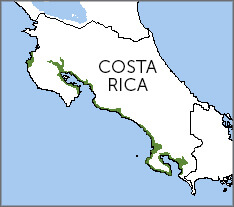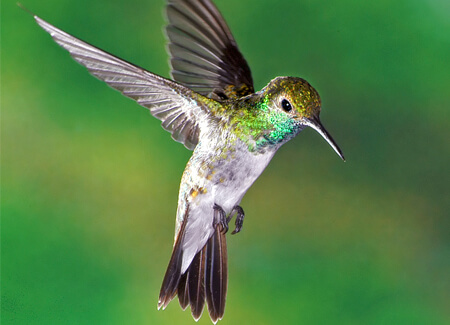 Imagine you're standing in the ocean with your back to the shore—then you see the Mangrove Hummingbird zip past. That's the usual way people lucky enough to see this bird experience it.
Imagine you're standing in the ocean with your back to the shore—then you see the Mangrove Hummingbird zip past. That's the usual way people lucky enough to see this bird experience it.
The species is found only in mangrove swamps and adjacent vegetation along the Pacific Coast. It's so closely tied to mangroves that the bird even prefers to feed on mangrove flowers.
This four-inch hummingbird is a Costa Rican specialty, and even within that small country, the bird is hard to spot.
Rising Waters, Sinking Species?
Sea level rise associated with climate change is one of the biggest threats to the Mangrove Hummingbird. Since mangroves are low-lying, any rise in surrounding waters could quickly inundate the species' limited habitat.
Habitat loss is another issue. Although mangrove logging is illegal in Costa Rica, trees are still cut to make room for shrimp aquaculture, road construction, and charcoal production. This ever-shrinking habitat puts Mangrove Hummingbirds and other vulnerable species at risk, including the Yellow-billed Cotinga, Black-cheeked Ant Tanager, and Turquoise Cotinga.
Sign up for ABC's eNews to learn how you can help protect birds

Mangrove Hummingbird, Michael Patricia Fogden
Oasis on the Osa
The species' limited range and declining numbers have led the International Union for Conservation of Nature to classify the Mangrove Hummingbird as Endangered. In 2008, our International Program and Osa Conservation established the Yellow-billed Cotinga Sanctuary in 2013, helping to protect mangroves essential to the hummingbird and other species.
In 2016, we celebrated the 10th anniversary of our sustainable tourism program, which is designed to prevent the extinction of some of the Americas' rarest bird species. Our reserve network now includes more than 70 tropical reserves, including the Yellow-billed Cotinga Sanctuary, and spanning close to one million acres. To date, the reserves have attracted well over 25,000 visitors, including birders, photographers, and trekkers whose entrance and accommodation fees have helped to finance reserve management and protection.
Birders and ecotourists can visit the Osa to see the Mangrove Hummingbird and other birds found nowhere else. Visit Conservation Birding to learn more.
Support the Hummingbird Effect!
In his recent book, Steven Johnson coins the term “Hummingbird Effect” to make the point that innovation in one realm can trigger unpredictable and unexpected advancement in others. We not only agree, but have dozens of examples of how great American bird conservation projects make considerable, sometimes unexpected contributions to other important causes including amphibian conservation, human health, food safety, climate change, water conservation, and home energy savings.
Donate to support ABC's conservation mission!



















































